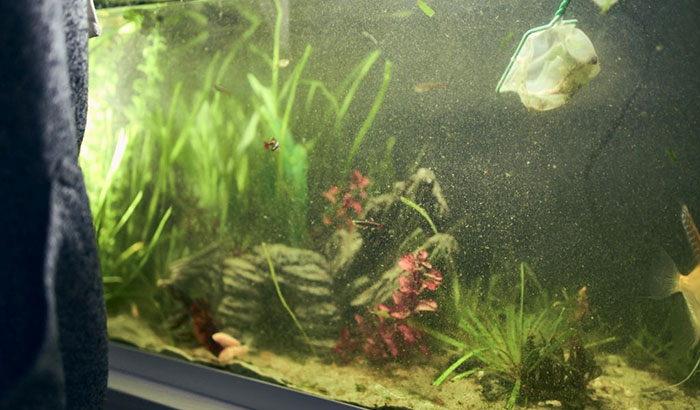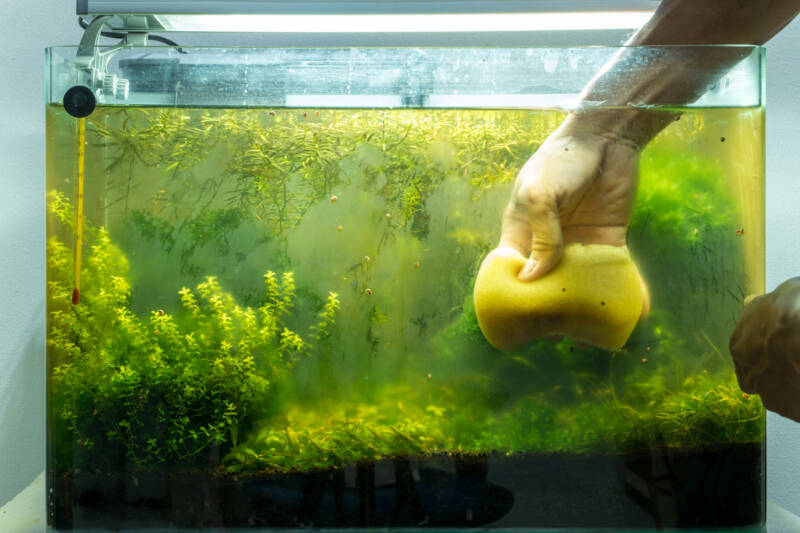Cloudy water in the freshwater aquarium
A well maintained aquarium is a jaw-dropping decoration for the interior. A study suggests that observing such a piece of nature in your home can improve both mental and physical wellbeing by e.g. reducing heart rate and blood pressure. However, anyone who has a fish tank, knows that it takes a lot of time and effort to keep it clean.
In this article, you are going to find out how to maintain optimal water quality in your aquarium, especially in a new one. Most aquarium owners would agree that one of the most serious problems that could spoil the impression of a particular tank is cloudy fish tank water. Nevertheless, there are some ways how to deal with it. We will establish that and delve into details to determine what are the causes of the cloudy aquarium water.

Aquarium water
First of all, we should figure out why we can't just let the aquarium live its own life. We need to understand that aquariums are artificially established micro aquatic environments in which various processes take place. Those processes can't be visible to the naked eye but some of them are beneficial to our ecosystem while some can be harmful to our underwater life.
Obviously, conditions in the fish tank will never be like those in nature. We can only try to mimic those conditions by doing several things. If we stop interfering in the aquarium, it will be a matter of time when it starts looking like an old rainwater container- dirty, full of algae and stinky because of the bacterial bloom.
Water quality is such an important thing because of the fact that fish and crustaceans breathe oxygen which is dissolved in the water. During the breathing, they also absorb other substances and chemical that are within the water. If the water quality is poor, the first symptoms of it, are cloudy water and an unpleasant smell.
Reasons of cloudy aquarium water and how to deal with them
There are many factors that can be responsible for cloudy fish tank water. Below, we will point out some of them and try to find the most efficient solutions for particular problems.

Immature tank
Most people will not like the following rule but you should be patient with establishing your new aquarium. If you pour tap water, add too many fish and live plants, it's not going to work out.
Firstly, in the aquarium water, there are many bacterias. Our task it to maintain beneficial bacterial colonies. If you've already started a brand new fish tank and you can still observe cloudy water, it means that your fish tank has not developed the optimal living parameters. It most likely happens because the nitrogen cycling process has not finished yet. It's wise to wait a little bit more for beneficial bacteria to appear in the new fish tank. The good bacteria appear step by step as you introduce new inhabitants and plants to the aquarium. It can take even a few weeks.
Remember: do not add many fish or plants at once, it can lead to ammonia and nitrites spikes which can be lethal to the livestock. It works like that, because every organism produces waste and a huge accumulation of compounds like: uneaten food, fish waste, decaying plants can lead to some irreversible changes.
If you put too many fish in your aquarium, the biological filter will not be able to get rid off all the harmful compounds they produce.
To read more about the nitrogen cycle and the new tank syndrome, click on the links.
Too frequent/ not enough water changes
Milky water in the aquarium can also appear after the water change. If you carry out this procedure too often, as well as cleaning the filter media, it strongly reduces the amount of beneficial bacteria within the aquarium water. As a result, the established tank can't naturally clean itself.
On the other hand, if you forget to perform water changes regularly, you can expect the same effect as above in the form of cloudy aquarium water. Some harmful compounds can't be removed from the aquarium and the only way to deal with it, is to do the water change to dilute them. Low nitrate levels are tolerated and do not influence the livestock at all.
The water in the established tank should be changed regularly every week in an amount from 20% to 40%. Learn how to perform efficient regular water change of the aquarium water with our BLOG!
Remember: rinse filter media in the aquarium water to avoid destroying beneficial nitrifying bacteria. Tap water could kill them all.

Inappropriate decorations
It's always a great idea to enrich your fish tank with ornaments for your organisms to have the possibility to hide in. However if you add e.g. badly prepared or too fresh driftwood or coconut shells, it can become a reason why you have cloudy aquarium water. Before adding driftwood to your fish tank, let it soak in a bucket of water. This is a durable decor but it will also decompose over time. During this process, wood releases tannin which will turn your water to the dark brown color. Not to mention that decomposing matter releases toxic compounds and as a result it increases ammonia and nitrate levels that can be lethal to your live plants and animals. The solution for this problem is rather easy. Just perform regular checks to ensure that natural decorations do not rot in the aquarium water. If so, remove them quickly.
By allowing this tannin to be released prior in a bucket you reduce this process. It is also a great method to add activated carbon media to your filter media basket that is quite efficient in cleaning the water. Read more about activated carbon here.
Even, artificial decorations are not the safest option if you forget about cleaning them, because it is the ideal place for debris to accumulate. In this case, remove manually dirt that accumulates on their surface. Obviously, they do not change the water chemistry unless you choose poor quality plastic ones, that will release toxic compounds into the water. Rely on proven brands.
Pro-tip: if debris is attached to your decorations, use an algae scrapper to remove it or rinse it in warm water.
Wrong substrate
Poorly selected substrate may be the site of putrefactive processes. The tank water turns color into dark, tea-like. You can collect the top layer of the substrate and then perform the water change. In this case, filtering wool cartridge in the filter media will be also helpful.
Overfeeding your fish
If you feed your animals too often or too much at once, they are not able to eat it. The fish food can pile up and destroy the aquarium balance.
Adult fish should be fed once or twice a day (depends on fish species). If they do not eat the food within a few minutes, you should remove the excess food or it will start to decompose and the next day you will see your fish tank cloudy.
Accumulating debris
Allowing for debris to accumulate for a long time also causes cloudy fish tank water. While changing the water, think about vacuuming the gravel and hire a special cleaning crew that will support the filter media. Otos, Amano shrimps or Black Mollys will be glad to do it. They'll combat the algae growth and will contribute to have crystal clear water.

Water quality
Cloudy aquarium water can appear because of the water you are using. Tap water contains heavy metals and chlorine.
Before performing a water change, you should add tap water conditioner and have your water tested often. Use special testing kits to monitor parameters. You may use a drop checker method to have your aquarium water pH levels constantly measured.
Green water
A green color of the water indicates that in your fish tank there is too much of algae. There are many reasons why the green water can occur in your fish tank.
First of all, too strong and long lighting can lead to the excess algae growth. Try to adjust the lighting. The placement of your aquariums is also really crucial. If you observe that your tank water gets greener, it may be taking too much sunlight. Algae live on sunlight like all other plants. Try to position it a little further to avoid direct sunlight. If this solution is not possible, cover your window with a curtain.
Secondly, if a filter media is insufficient, your fish tank will get cloudy and dirty for sure. High performing filter is the best way to remove algae and debris from your tank. This purchase will eventually pay off so do not spare money on this device. The fish tank filter should be adapted to the tank size.

Summary
In most cases, we see cloudy aquarium water because of natural causes. The very first thing to do should be to prevent it before even occurring. There is no better way than controlling water parameters. Testing kits will let you know what you are struggling with and what steps you should implement.
However if you notice the first symptoms of cloudy aquarium water, don't panic. The good news is that cloudy water isn't the end of the world. In fact, there are some simple ways to diagnose and treat it.




